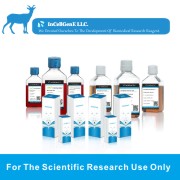

Overview
| Organism | Homo sapiens, human |
|---|---|
| Tissue | eye; retinal pigmented epithelium; retina |
| Cell Type | Epithelial |
| Product Format | frozen |
| Morphology | epithelial |
| Culture Properties | adherent |
| Biosafety Level |
1
Biosafety classification is based on U.S. Public Health Service Guidelines, it is the responsibility of the customer to ensure that their facilities comply with biosafety regulations for their own country. |
| Disease | normal |
| Age | 19 years |
| Gender | male |
| Applications |
This cell line is a transfection host.
|
| Storage Conditions | liquid nitrogen vapor phase |
Properties
| Karyotype | diploid |
|---|---|
| Derivation |
ARPE-19 is a spontaneously arising retinal pigment epithelia (RPE) cell line derived in 1986 by Amy Aotaki-Keen from the normal eyes of a 19-year-old male who died from head trauma in a motor vehicle accident.
The line was established in a 1:1 mixture of Dulbecco''s modified Eagles medium and Ham''s F12 medium with HEPES buffer containing 20% fetal bovine serum, 56 mM final concentration sodium bicarbonate and 2 mM L-glutamine and incubated at 37C in 10% CO2.
The cells were subjected to selective trypsinization for the first four passages to remove superficial cells before passaging the cuboidal basal layer. By passage 5, the cultures appeared to be rapidly growing RPE cells, which would form cobblestone monolayers, which pigmented after several months in culture. |
| Clinical Data |
male
19 years
|
| Antigen Expression |
RPE-specific markers CRALBP and RPE-65
|
| Genes Expressed |
RPE-specific markers CRALBP and RPE-65
|
| Comments |
These cells form stable monolayers, which exhibit morphological and functional polarity. ARPE-19 expresses the RPE-specific markers CRALBP and RPE-65.
The cells exhibit morphological polarization when plated on laminin-coated Transwell-COL filters in medium with a low serum concentration.
They form tight-junctions with transepithelial resistance of monolayers reaching a maximum of 50 to 100 ohms/cm2 after 4 weeks of culture.
The cells are diploid and can be carried for over 30 passages. Progeny were found to undergo an additional 48 population doublings in longevity trials performed during characterization at ATCC.
|
Background
| Complete Growth Medium |
The base medium for this cell line is ATCC-formulated DMEM:F12 Medium Catalog No. 30-2006. To make the complete growth medium, add the following components to the base medium: fetal bovine serum to a final concentration of 10%. |
|---|---|
| Subculturing |
Volumes are given for a 75 cm2 flask. Increase or decrease the amount of dissociation medium needed proportionally for culture vessels of other sizes. Corning® T-75 flasks (catalog #430641) are recommended for subculturing this product.
Subcultivation Ratio: A subcultivation ratio of 1:3 to 1:5 is recommended
Medium Renewal: Two to three times weekly
|
| Cryopreservation |
Freeze medium: Complete growth medium supplemented with 5% (v/v) DMSO
Storage temperature: liquid nitrogen vapor phase
|
| Culture Conditions |
Atmosphere: air, 95%; carbon dioxide (CO2), 5%
Temperature: 37��C
|


